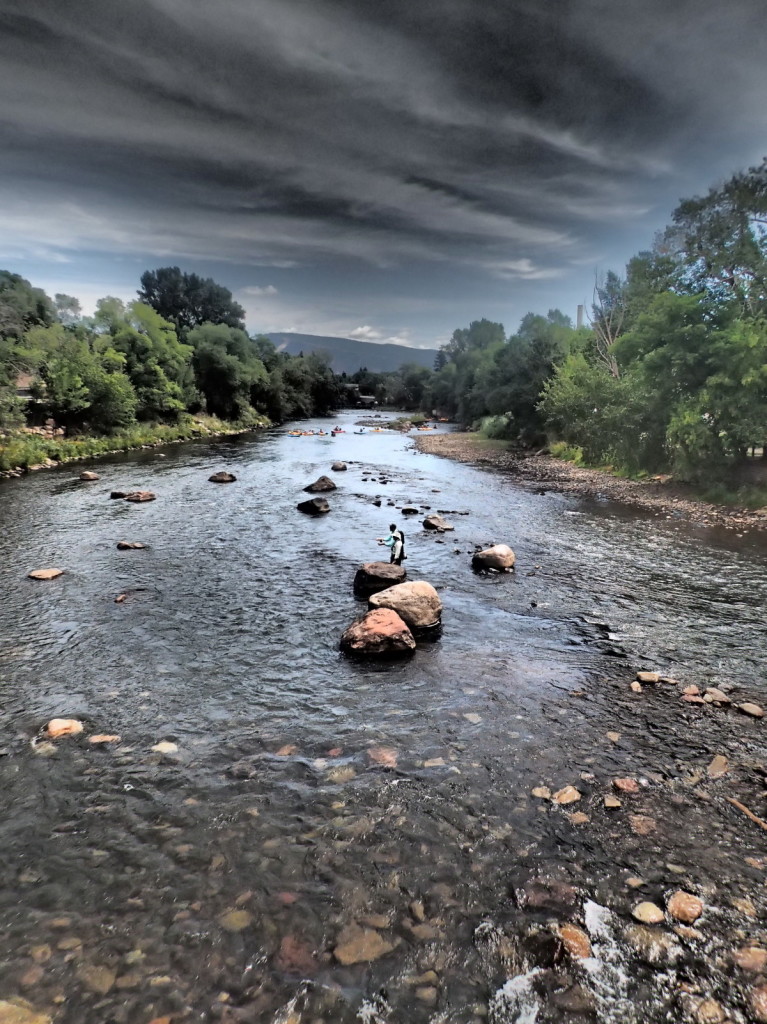River Conditions in August
August, the final month of summer break before it’s back to school, falling leaves, and brisk weather…but lets not get ahead of ourselves, let’s discuss the fishing here in the southwest part of the state right now! It may be good to think of August as the culmination of the first 2/3rds of the summer. With runoff, monsoons, and major hatches behind us: the fish will become more opportunistic. Trout will begin to fatten up for the fall as well as to spawn in the case of brown trout. Some also claim that August is the best month to hit the high country, and we really can’t disagree with that assessment.
With August comes slightly cooler summer temps; and with cooler temps comes opportunities that did not exist the past 4 weeks. Fish will be looking up to eat on top during the day. Terrestrials will be out in full force, feeding hungry trout. Cooler evening temps mean that you can pretty much fish 24 hours a day if you want. I know we are!
Another thing to note: on July 30th, the Bureau of Reclamation increased flows on the San Juan below Navajo Reservor to 900cfs. What this means is GREAT float fishing. Fish have been looking up to hoppers, ants, PMDs…heck, pretty much anything that looks like a bug. They have been looking up and crushing dries, hard. Drop all your responsibilities and get to the Juan to float now. Don’t have a boat? Give us a call and book a day float. If you are feeling slightly more adventurous, ask about floating the lower San Juan; the fishing has been just as good with dries without the crowds.
And one more thing: a mouse pattern in the evenings or mornings; wherever…just keep that in mind.
Insects and Natural Food Sources
San Juan – Hoppers! Midge pupa, larva, and adults. Annelids, aquatic worms, scuds, eggs, leeches, BWOs, caddis, large ants, and baitfish in the lower reaches.
Animas – Caddis, BWOs, PMDs, Sculpins, Fingerling Rainbow Trout, Crayfish, Mice, Hoppers, Ants, and Beetles.
Rio Grande – Caddis, BWOs, PMDs, Hoppers, Beetles, Ants, stonefly nymphs, and Mice.
Piedra River & Williams Creek–Hoppers, Ants, Beetles, Caddis, PMDs, Stonefly nymphs, Craneflies, Sculpin and baitfish.
Los Pinos River – (Below Dam) Hoppers, Midges, PMDs, Caddis, Scuds, Baitfish & Leeches.
Dolores River Above Reservoir, Los Pinos Above Reservoir – Ants, beetles, Hoppers, PMDs, Caddis, Mice.
Dolores River (Below Dam) – Hoppers, Ants, Beetles, PMDs, Caddis, Midges, BWO’s, Rattlesnakes (No seriously lots of rattlesnakes so watch out). Flows are really low so fish are skittish.
High Country Lakes and Streams – Hoppers, Ants, Beetles, Moths, Caddis, Mice. Damselflies, Chronomids, and Callebaetis in lakes.
Recommended Fly Patterns
Animas, Rio Grande, and SW CO rivers: A good assortment of terrestrials such as Foam Ants, Chernobyl Ant, Foam Trude, Foam Beetle, Hoppers in size 8-12 such as Chubby Chernobyl, Grillo’s Pool Toy, Olive Madam X, Turk’s Tarantula, Parachute Hopper. Green or black caddis larva and cased caddis nymphs, Hares Ear Nymph, Graphic Caddis, sparkle emerger sz. 12-18. Foam Caddis, Elk Hair Caddis, Olive X-Caddis, Parachute Caddis, all size 12-20. For Streamers Olive Krystal Buggers, Meat Whistle, Autumn Splendor, Near Nuff Crayfish, Near Nuff Sculpin, Josh’s Ziwi in sizes 2-10. After a rain it may also be a good idea to pack a few Pat’s rubberlegs or a cranefly larva imitation.
San Juan River: Foam Ants, Foam Trude, Foam Beetle, Flying Ant Hoppers in size 8-12 such as Chubby Chernobyl, Grillo’s Pool Toy, Royal Madam X, Turk’s Tarantula, Parachute Hopper. Olive and tan scuds sizes 14-18. BWO’s Sz.18-22; Two Bit Hooker, Juju baetis, WD-40s, Pheasant Tail, RS-2s, CDC Comparaduns. Midges Sz.18-26; Scissorbill Special, Red Brassie, Big Mac, Griffith Gnats, and Zebra Midges. Brown, Olive, and White bunny leaches or buggers of the same color. Tan chamois Leeches size 16. Red annelids Sz. 20-22. San Juan Worms, Sz. 16-20 in tan, pink, or orange. Egg patterns, Sz. 16 in orange, pink, and cherise.
For the high country streams and lakes; TERRESTRIALS! Foam flying Ant, Foam Trude, Parachute Hopper, Size 8 Chubby Chernobyl, Humpies, Royal Wulffs, Stimulators, Elk Hair Caddis, Turks Tarantula, and Parachute Adams on hand in sizes 8-16. If you must go under, a size 10 Olive and Brown Buggers, Copper Johns, and Pheasant Tails. If you are headed to a lake, make sure to have some Damselflies (small olive bugger), Chronomids (Large Midge Pupa), Callebaetis (Hares Ears and parachute Adams), and a few mouse patterns…










Planning a trip to Durango in middle of Oct. what flies should I bring or purchase? Animas river is our target.
thanks,
Jim Bevan
Hello Jim,
There will be a few things to be aware of for October. October usually sees the bigger browns moving around getting ready to spawn. Big browns in the fall mean big streamers. Olive, yellow, and black sculpins, buggers, and baitfish will be where it is at. You may also consider a mouse or two. Other than that the major hatches of fall is the Blue Winged Olive, size 18 to 22 and midges of the same size. Black Beauties, RS-2s, Pheasant tails, as well as midge and BWO dries will be the ticket. Bead head prince nymphs are also a great producer so make sure to have some of those as well as an assortment of bead head nymphs that will represent small dark mayflies, cased caddis, and a stonefly or two. Stop in the shop when you get into town for any additional help and specific fly patterns.
Thanks,
Andy
Add to email newsletter